Housing in Bar Harbor is Complicated and the Town Is Not Alone
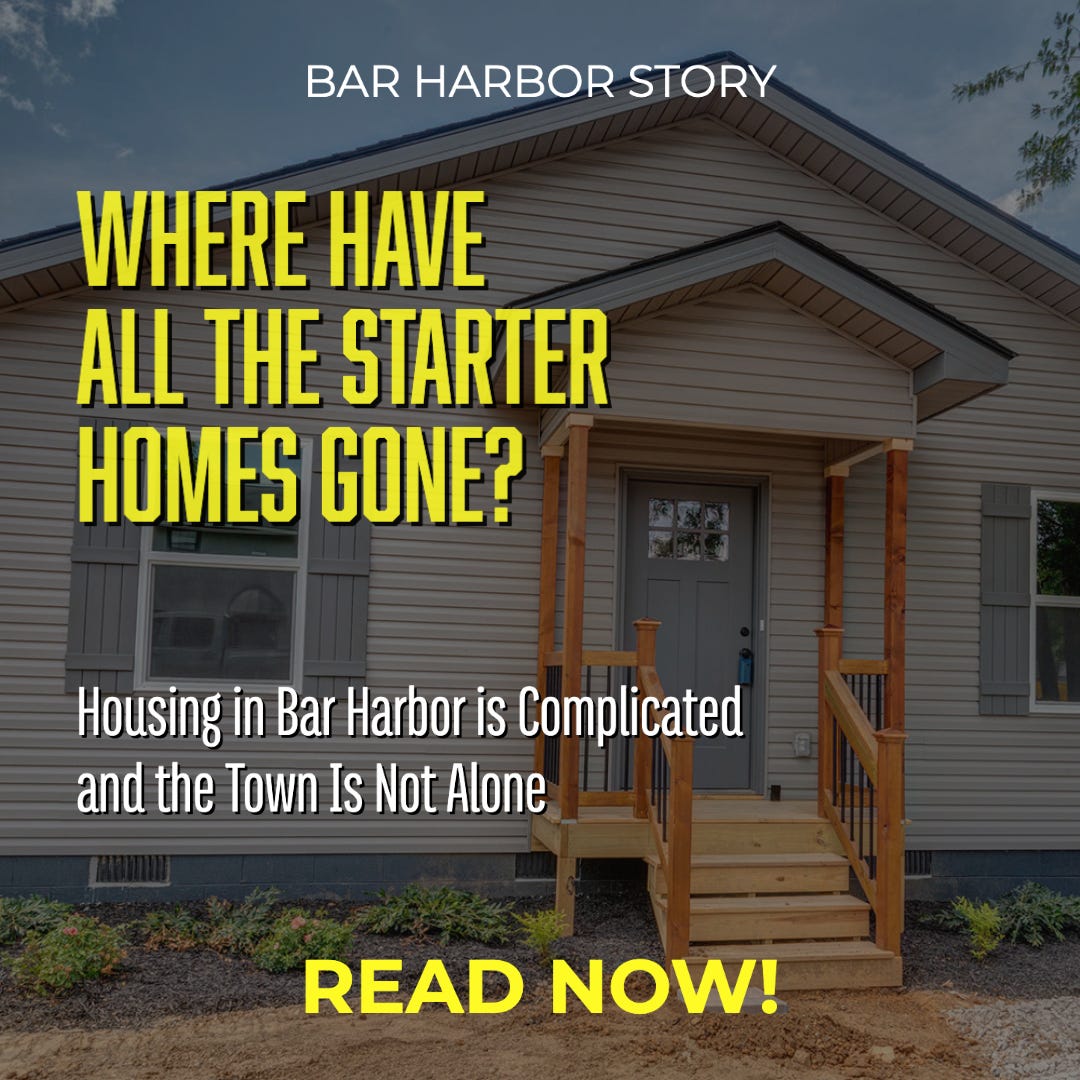
BAR HARBOR— A myriad of local and national circumstances and past decisions have created an increasingly complex housing situation in Bar Harbor that has led to few to no starter homes currently available in the area.
This Monday, the Bar Harbor Town Council will hear a presentation about “An Examination of Bar Harbor’s Development Process” report, and on Wednesday, the Bar Harbor Planning Board will discuss an application from KOA (Kampgrounds of America) that involves dormitory-style RVs at its Town Hill site.
Starter homes, which are usually less expensive and smaller than a majority of homes in an area, are a person’s first purchased home. Typically, these homes help people build equity so that they can move to bigger houses. Freddie Mac defines these dwellings as homes with 1,400 square feet or less. As of this weekend, only two houses in Bar Harbor qualify as starter homes. One is 980 square feet and listed at $299,000. The other is 1,285 square feet and listed at $425,000. They are also the least expensive homes currently for sale in Bar Harbor.
According to an article by Freddie Mac, “The Bureau of the Census reports that in 1980, 40% of homes constructed were entry-level homes. In 2019, only 7% of homes constructed were entry-level homes.”
The problem is nationwide and local.
“Affordable houses don’t exist anymore” when it comes to building starter homes said Linda Farnsworth Higgins who has been a realtor and broker at LS Robinson since 1987. Higgins said one reason is the cost to buy land and then to bring in septic, utilities, and putting in a well. Even a home without upgrades like granite countertops are coming in around $350,000 or $400,000 to build, she said. With currently increasing interest rates, that’s putting those homes just out of reach for a lot of buyers.
Builders aren’t incentivized to construct those starter homes because for the same amount of labor, a builder can create an above-grade dwelling with those fancier amenities and be able to pay his employees more or offer them health insurance. Similarly, a subcontractor can make more money than being a laborer for a builder and that adds to the cost to the builder, often making construction companies hustle to get enough employees to build houses. An employee wants to be paid competitively, and employers also have to pay for unemployment and Social Security, which increases the bottom line for construction companies.
Realtor, landlord, and former Bar Harbor Planning Board member Erica Brooks said,
“From reading real estate trade magazines over the last 15+ years, I can tell you another component to the overall lack of supply is due to the labor market. Even if a developer is permitted to build twenty to forty homes over the course of 18 -24 months, are there enough skilled tradespeople to do so in their region? The push for higher education over the last thirty years with hardly any push for trade schools has left us with a dwindling labor pool in many key areas related to housing. Now we are living in a post-Covid world where supply chains are just starting to normalize, which was another barrier to entry for developers nationwide.”
Higgins agreed about the problem and components.
“There’s no one red button to stop this. There are a lot of yellow buttons. People need to be making more money to afford to live today and when you have to pay people more money. . . well, it’s a vicious cycle,” Higgins said, adding that first-time home buyers have a hard time competing for houses in a tight market where sellers are going for offers that are all cash and with no contingencies.
Higgins said that she thinks there may be some creative ways of dealing with housing shortages and costs on Mount Desert Island, but that it would likely require larger employers and the town governments becoming involved.
In the recent past, Bar Harbor has adopted changes about employee living quarters, shared accommodations and bonus dwelling units to try to alleviate the problem.
Multiple Factors Contribute To Housing Shortages
On September 25, the New York Times’ Emily Badger wrote a feature “Whatever Happened to the Starter Home?” where she said,
“The disappearance of such affordable homes is central to the American housing crisis. The nation has a deepening shortage of housing. But, more specifically, there isn’t enough of this housing: small, no-frills homes that would give a family new to the country or a young couple with student debt a foothold to build equity.”
Badger writes that multiple factors have created this housing shortage. Land costs more. Like Higgins said, the cost to build houses is more expensive because of building materials and labor costs. There are a lot more regulations and fees from governments.
As land and lots became more expensive, she writes, instead of decreasing required lot sizes to build on, towns and cities increased the minimum lot size. They also often created stricter rules about setbacks and design. And those changes often stem from towns and cities trying to make their best communities, Badger says.
The development study that town councilors will hear about on Monday is part of the 2019 Housing Policy Framework’s strategy #4, which is meant to “identify if the LUO (land use ordinance) creates barriers to the development of affordable workforce housing.”
The conversations with twelve local professionals found that:
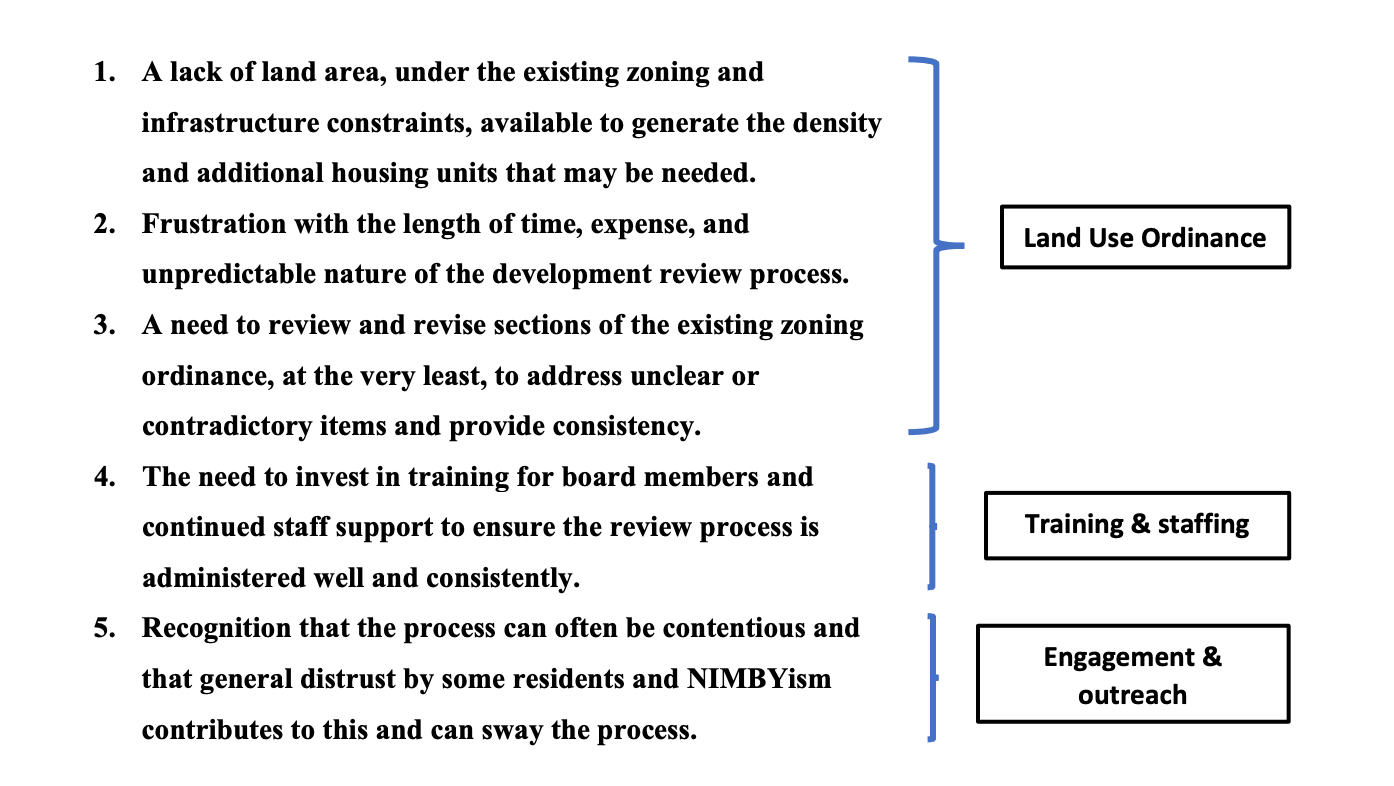
Among many possible actions to “remove barriers to development” the report recommends “revising the foundation” of the town’s “land use ordinance to simplify the administrative framework and procedures such as conflicting language” and also to “explore: a) decreasing the number of and/or combining zoning districts; b) revising dimensional requirements including setbacks, height, lot coverage and housing density; and c) revising parking setbacks from roads.” It also mentions potentially expanding where employee housing can be situated within the town as well as “look at other options such as employee campsites.”
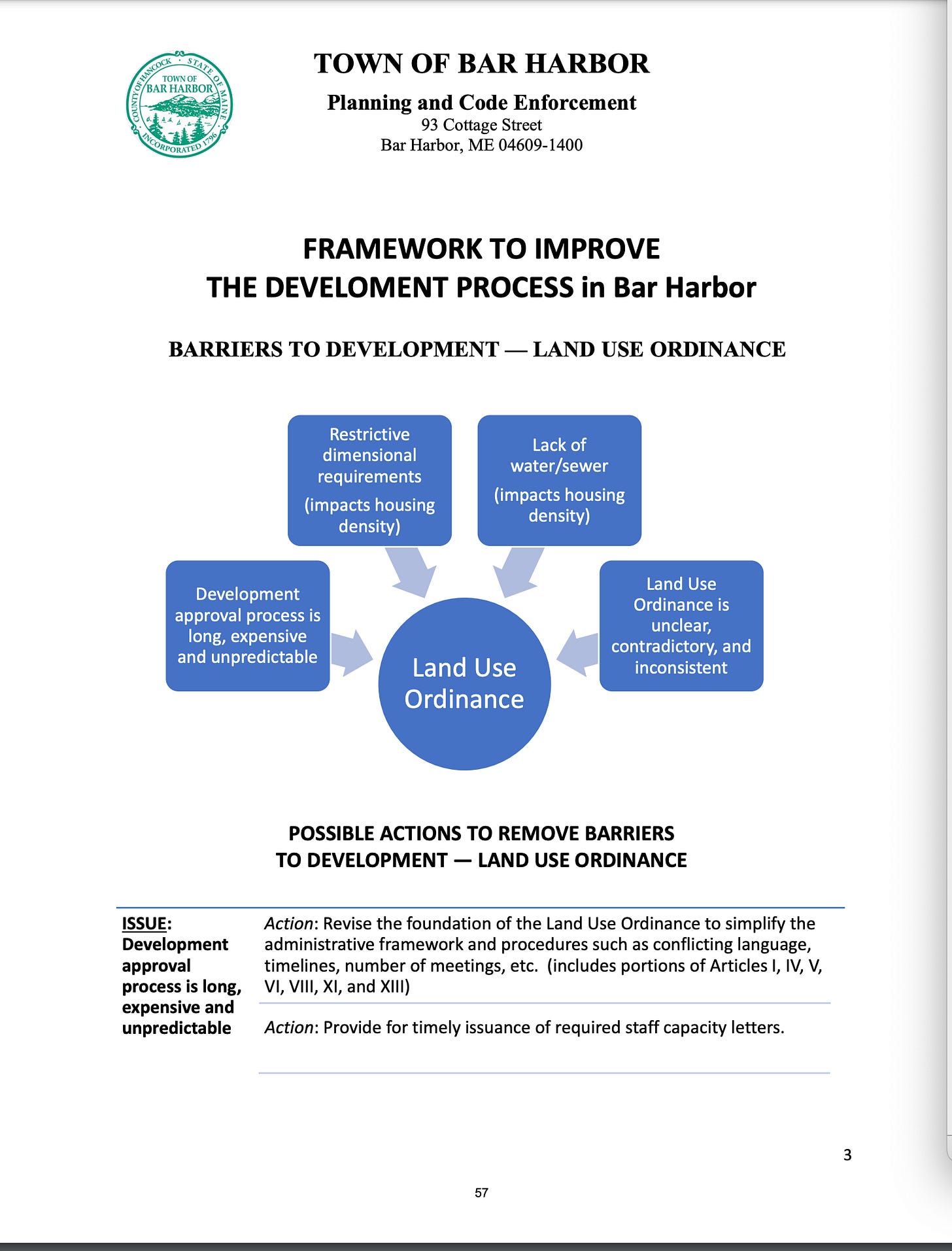
Brooks said,
“Taking a more macro approach, we know that nationwide ‘sprawl’ is a real thing, and if properly managed and planned for the right infrastructure and zoning, rules can be implemented to create bedroom communities offering a win-win for society as a whole. To bring it back to a micro economics’ point of view, we can look at the Town of Bar Harbor’s thirty-something developable zones and then realize that the lack of planning and foresight has created a major supply issue. Sprawl is imminent. Demand is imminent. What tools does the Town of Bar Harbor have to truly combat the housing crisis? There are many options by way of amending our land use and overall changing policy. Very little has actually been done to truly create more supply by way of amending land use to 1) encourage higher density 2) encourage more multifamily projects and 3) encourage long term housing options. It is extremely frustrating as a person who understands the housing market and our LUZO intimately as a realtor, landlord, and former planning board member to hear the Town Council and Planning Department toss around the buzz words ‘housing crisis’ when there are few solutions being implemented.”
Other realtors who wished to remain anonymous for the article said that despite Bar Harbor’s short-term rental ordinances which caps certain types of vacation rentals, there is no increase in affordable housing supply. Higgins said that other communities have seen an increase in property buyers purchasing homes to host vacation rentals. One realtor said there may be a few more long-term rentals on the market since that change, however, most of those are offered for over $2,000 a month.
An August 11, 2022 Portland Press Herald piece states, “The enforcement of a cap on non-owner-occupied rentals in Bar Harbor, for example, has led to spillover into neighboring towns, according to recent reporting, spurring these communities to consider caps of their own.”
AFFORDABILITY
Recently, much of the town’s efforts have been on curtailing short-term rentals, which was the first strategy of the 2019 housing policy framework. Other strategies in the document are to develop zoning for employees, a housing needs assessment and action plan, identify zoning barriers to housing, ensure quality rental housing, reduce red tape, secure a forty-acre Town Hill parcel of National Park Service land, create partnerships with large employers in respect to housing, and create community partnerships (as well as maintain them) to address housing needs as well as focusing on low-and-moderate income housing, which is defined as “earning less than 50% to 120% of the area’s median income.”
The median household income (in 2020 dollars) for Hancock County, Maine from 2016-2020 was $58,345. There are approximately 56,192 people in the county and almost 90% have lived in the same house for more than a year.


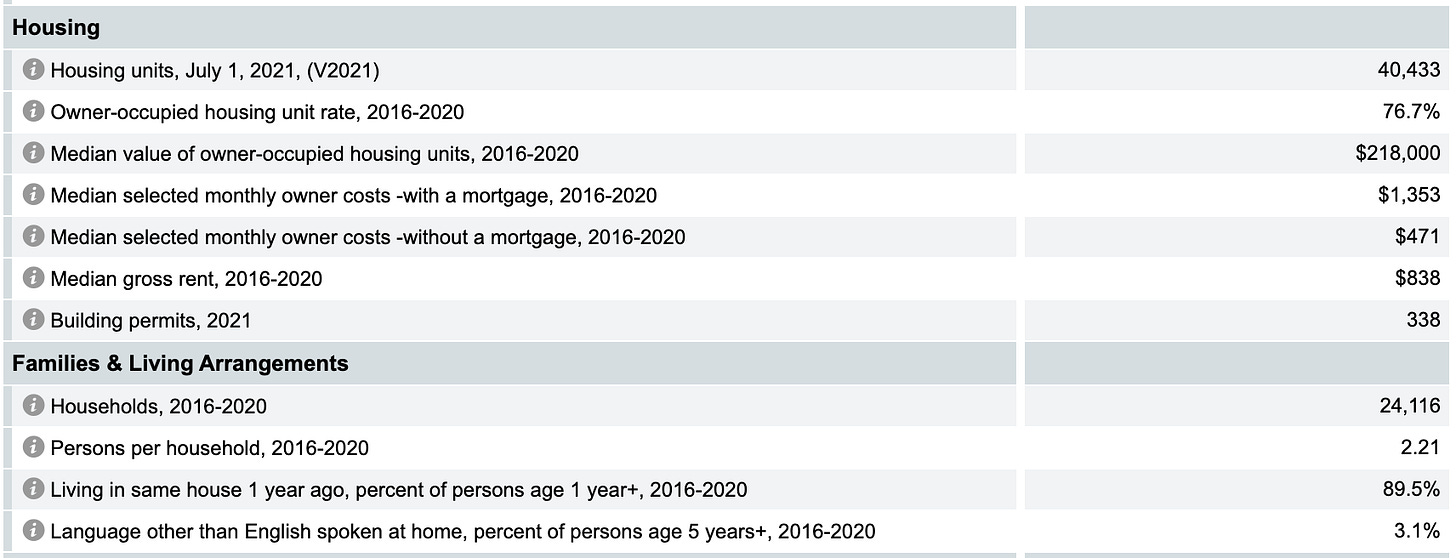
The U.S. Census Bureau did not have a number of housing units in Bar Harbor listed, but did have an owner-occupied rate and other facts that are included in the charts below. The Bar Harbor mean household income was approximately $10,000 more than the rest of Hancock County.

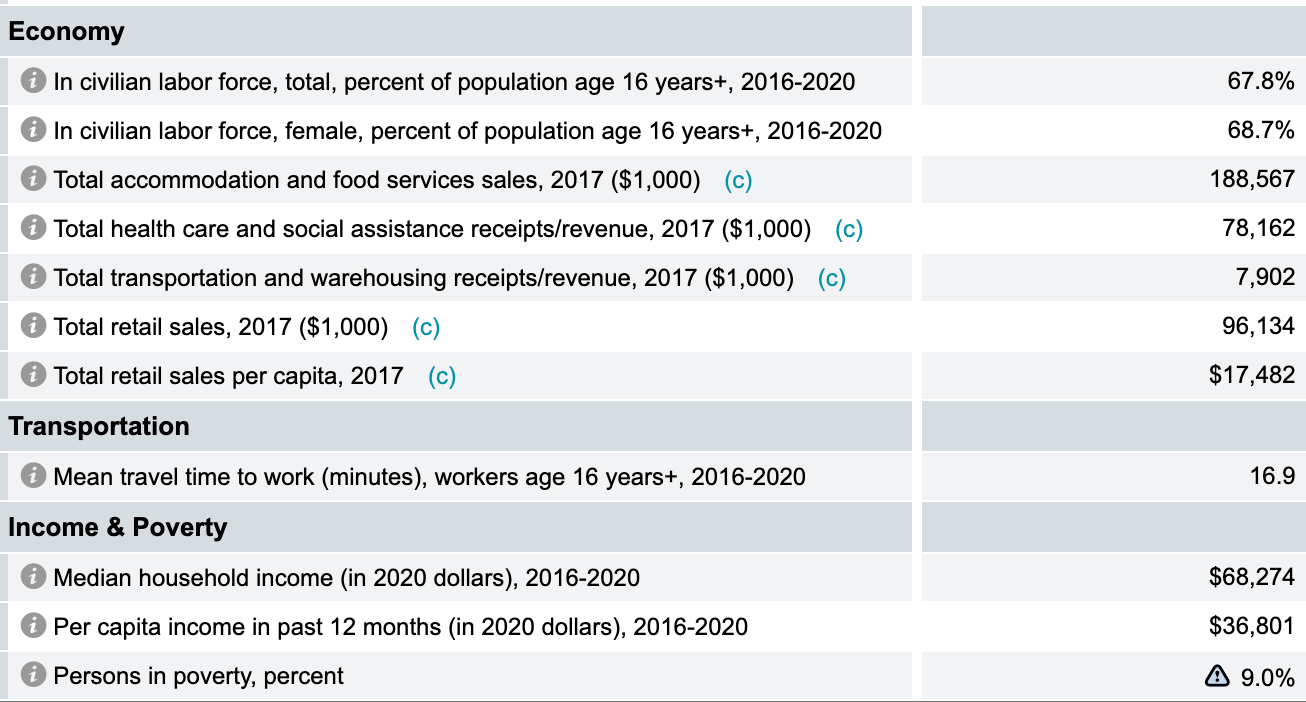
SUPPLY AND DEMAND
Brooks said, “When a developer pays a premium to buy land on MDI then looks at the zoning to see the area per family is 20,000-40,000 square feet or that Multi-Family 1 & 2 are not a permitted use, guess what happens? Supply continues to be limited. Lack of supply coupled with an economic boom, low interest rates, and higher buying power created a perfect storm not only here on MDI but across the country. Developers are tax payers, employers and are in the industry to ultimately make a profit (careful saying that swear word here on MDI); if there is no incentive to develop long term, affordable housing via policy and land use then a developer will look to what does create sustainability and profit naturally.”
Badger’s article says similar sentiments and also delves into the good intentions of town planners and officials in the last few decades as they tried to build, design, and encourage communities.
“This mix of good intentions (energy efficiency, tree preservation) and exclusionary ones (aesthetic mandates, minimum lot sizes) has pushed up the cost of building on top of the rising cost of land. Cities have also shifted more of the burden for funding public infrastructure like parks and sewer systems off taxpayers and onto homebuilders,” Badger writes.
That makes those starter homes not something easily created. Bigger lot sizes and more building restrictions keep home values from dropping, but they also increase the cost of land that can be developed. When houses have to be a certain distance apart, then each dwelling requires more land to be built on.
Across the country, a lot that could once hold four houses in a community might now only legally be able to hold one. At the same time, one island broker said that Mainers still want those larger lots and the privacy that they entail, plus, a larger lot allows people to garden, store their boats or all-terrain vehicles and cars.
Despite the recent tiny home movement, America has had a bit of a larger is better mentality in the last few decades and that also feeds into the lack of smaller starter homes.
Badger writes,
“Nationwide, the small, detached house has all but vanished from new construction. Only about 8 percent of new single-family homes today are 1,400 square feet or less. In the 1940s, according to CoreLogic, nearly 70 percent of new houses were that small.”
Without starter homes, people can’t build equity. Starter homes help stabilize a community. Starter homes allow people to not give their money to their landlords and have stability in their own costs via mortgage rather than rent.
After the 1950s, Americans began to move away from rural spaces with cheap land and go toward cities where there was more employment. Then cities increasingly passed zoning ordinances and rules that made building more difficult. Housing costs increased. Renting became more necessary. In a September 25 Wall Street Journal article, Kondra Putzier writes,
“Land values in Manhattan barely increased between the 1880s and 1970s after adjusting for inflation, according to calculations by Jason Barr, an economist at Rutgers University-Newark. But between 1977 and 2019, they grew at an average annual rate of about 13%.
“Most economists say municipalities need to relax zoning rules and other restrictions to bring down land inflation and build more housing. But these changes are often unpopular with homeowners, who benefit from rising land values and make up around 65% of U.S. households. Adding more housing also often requires costly investments in roads and other infrastructure.”
At the same time, the NAHB’s Robert Dietz said in a statement, “Tighter monetary policy from the Federal Reserve and persistently elevated construction costs have brought on a housing recession.”
Single-family starts are projected to fall this year, which Dietz said was “the first such decrease since 2011.”
Bar Harbor, MDI and the United States are not alone. Europe also has housing issues
According to Kim van Sparrentak, a member of the European Parliament,
“Europe is in the midst of a housing crisis. From Paris to Warsaw, Dublin to Athens, an increasing number of people in the EU are struggling to afford the rising cost of housing. Even before the start of the pandemic, one in ten Europeans were spending more than 40% of their income on housing. In urban areas in particular, many people find themselves in a dire situation and are driven out of the city. Also, the quality of housing is often deplorable. Far too many people in Europe are living in overcrowded dwellings and damp or poorly insulated homes, with unaffordable utility bills.”
Anne Barrington writing for The Irish Times says,
“More and more ordinary working people are priced out of the housing market in major cities round Europe. In Ireland, it is taking longer and longer for young people to find a decent place to live away from home. The recent National Longitudinal Study of Children indicated that 17- to 21-year-olds put housing as their number one concern.”
The Island Housing Trust (IHT) is a local nonprofit that since 2003 has created 48 projects to increase the number of houses for the workforce on MDI and earlier this year raised $3.5 million toward year-round housing on the island. One of its projects is the Jones Marsh neighborhood and it also has home ownership assistance programs. As of earlier this year, the organization has helped 143 children and adults.
LAND SHORTAGES
Putzier writes, “The United States, a country of wide open spaces, is short on land.”
That’s also especially true for Bar Harbor and Mount Desert Island where Acadia National Park takes up 10,156 acres of Bar Harbor and 30,500 acres of the island. Brooks agreed, saying, “Overall on MDI we have to think about simple supply and demand. Two-thirds of the island is made up of national park, nature conservations, or undevelopable land (wetlands, etc.). This makes for a smaller supply overall so with less supply the prices are higher. The demand for on island housing has increased even more over the years in conjunction with a booming economy, good press for ANP and Bar Harbor and of course Covid pushed things over the edge with demand too.”
Putzier goes on to write, “Land-use restrictions and a lack of public investment in roads, rail and other infrastructure have made it harder than ever for developers to find sites near big population centers to build homes.”
Bar Harbor’s September 15, 2022 development study also mentions infrastructure worries for development and increased density.
Brooks agrees that the town’s land use ordinance is another source of issues when it comes to the supply of land and housing. “The Town of Bar Harbor has thirty-nine zoning districts,” she said. “Several of those districts do not even allow for residential uses. The other thirty-something have extreme restrictions in terms of permitted use, setbacks, lot coverage and the #1 culprit of all ‘ area per family.’ ”
Neither the housing policy framework or recent development study specifically mention “area per family,” which is a part of the town’s land use ordinance.
While MDI is hardly a big population center, it does attract a million visitors each year and has only a certain amount of buildable land. Putzier cites Morris Davis, a professor at Rutgers’ Business School who said the value of residential land in the U.S. is most likely worth more than $20 trillion. He also believes that the land a home sits on comprises 47% of all the home’s value. In the early 1960s that number was 20% and in 2012 it was 38%.
“For what seems like a very complex and complicated issue there is always a workable, practical solution especially if politics are taken out of the mix. At the end of the day, we all want to live, work, play in a safe, happy and healthy community and that is very much possible if we all get back to the basics. The American Dream is alive and well if we can all take off the jaded glasses to see it, appreciate it, and work together to preserve it,” Brooks said.
Both the Bar Harbor Town Council meeting on Monday and Planning Board meeting on Wednesday are open to the public and streamed live. A series of comprehensive plan community sessions are also scheduled.
SO MANY RESOURCES SO YOU CAN LOOK INTO THINGS, TOO!
LINK TO DEVELOPMENT STUDY (begins at page 55)
LINK TO THE 2019 BAR HARBOR HOUSING POLICY FRAMEWORK
LINK TO EARLY SEPTEMBER PB ARTICLE ABOUT THE CAMPGROUND/DORM RVS.
U.S. Census Bureau Quick Facts – Hancock County
U.S. Census Bureau Quick Facts – Bar Harbor
“How Many Starter Homes Are Being Built in Your State?”
Recent Zillow search for Bar Harbor homes
https://legislature.maine.gov/doc/8867
https://www.oecd-forum.org/posts/tackling-europe-s-housing-crisis


One thought on “Where Have All The Starter Homes Gone?”